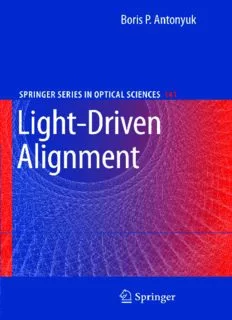
Light-Driven Alignment PDF
Preview Light-Driven Alignment
SpringerSeriesin 141 OPTICAL SCIENCES foundedbyH.K.V.Lotsch Editor-in-Chief:W.T.Rhodes,Atlanta EditorialBoard:A.Adibi,Atlanta T.Asakura,Sapporo T.W.Hänsch,Garching T.Kamiya,Tokyo F.Krausz,Garching B.Monemar,Linköping H.Venghaus,Berlin H.Weber,Berlin H.Weinfurter,München SpringerSeriesin OPTICAL SCIENCES TheSpringerSeriesinOpticalSciences,undertheleadershipofEditor-in-ChiefWilliamT.Rhodes,Geor- giaInstituteofTechnology,USA,providesanexpandingselectionofresearchmonographsinallmajor areasofoptics:lasersandquantumoptics,ultrafastphenomena,opticalspectroscopytechniques,opto- electronics,quantuminformation,informationoptics,appliedlasertechnology,industrialapplications, andothertopicsofcontemporaryinterest. Withthisbroadcoverageoftopics,theseriesisofusetoallresearchscientistsandengineerswhoneed up-to-datereferencebooks. Theeditorsencourageprospectiveauthorstocorrespondwiththeminadvanceofsubmittingamanu- script.SubmissionofmanuscriptsshouldbemadetotheEditor-in-ChieforoneoftheEditors.Seealso www.springer.com/series/624 Editor-in-Chief WilliamT.Rhodes GeorgiaInstituteofTechnology SchoolofElectricalandComputerEngineering Atlanta,GA30332-0250,USA E-mail:[email protected] EditorialBoard AliAdibi Max-Planck-InstitutfürQuantenoptik GeorgiaInstituteofTechnology Hans-Kopfermann-Straße1 SchoolofElectricalandComputerEngineering 85748Garching,Germany Atlanta,GA30332-0250,USA E-mail:[email protected] E-mail:[email protected] BoMonemar ToshimitsuAsakura DepartmentofPhysics Hokkai-GakuenUniversity andMeasurementTechnology FacultyofEngineering MaterialsScienceDivision 1-1,Minami-26,Nishi11,Chuo-ku LinköpingUniversity Sapporo,Hokkaido064-0926,Japan 58183Linköping,Sweden E-mail:[email protected] E-mail:[email protected] TheodorW.Hänsch HerbertVenghaus Max-Planck-InstitutfürQuantenoptik FraunhoferInstitutfürNachrichtentechnik Hans-Kopfermann-Straße1 Heinrich-Hertz-Institut 85748Garching,Germany Einsteinufer37 E-mail:[email protected] 10587Berlin,Germany E-mail:[email protected] TakeshiKamiya HorstWeber MinistryofEducation,Culture,Sports ScienceandTechnology TechnischeUniversitätBerlin NationalInstitutionforAcademicDegrees OptischesInstitut 3-29-1Otsuka,Bunkyo-ku Straßedes17.Juni135 Tokyo112-0012,Japan 10623Berlin,Germany E-mail:[email protected] E-mail:[email protected] FerencKrausz HaraldWeinfurter Ludwig-Maximilians-UniversitätMünchen Ludwig-Maximilians-UniversitätMünchen LehrstuhlfürExperimentellePhysik SektionPhysik AmCoulombwall1 Schellingstraße4/III 85748Garching,Germany 80799München,Germany and E-mail:[email protected] Boris P. Antonyuk Light-Driven Alignment With119Figures ProfessorDr.BorisP.Antonyuk RussianAcademyofSciences,InstituteofSpectroscopy 142190Troitsk,Russia E-mail:[email protected] SpringerSeriesinOpticalSciences ISSN0342-4111 e-ISSN1556-1534 ISBN978-3-540-69887-6 e-ISBN978-3-540-69888-3 LibraryofCongressControlNumber:2008930094 ©Springer-VerlagBerlinHeidelberg2009 Thisworkissubjecttocopyright.Allrightsarereserved,whetherthewholeorpartofthematerialiscon- cerned,specificallytherightsoftranslation,reprinting,reuseofillustrations,recitation,broadcasting,repro- ductiononmicrofilmorinanyotherway,andstorageindatabanks.Duplicationofthispublicationorparts thereofispermittedonlyundertheprovisionsoftheGermanCopyrightLawofSeptember9,1965,initscur- rentversion,andpermissionforusemustalwaysbeobtainedfromSpringer-Verlag.Violationsareliableto prosecutionundertheGermanCopyrightLaw. Theuseofgeneraldescriptivenames,registerednames,trademarks,etc.inthispublicationdoesnotimply, evenintheabsenceofaspecificstatement,thatsuchnamesareexemptfromtherelevantprotectivelawsand regulationsandthereforefreeforgeneraluse. TypesettingbytheauthorsandVTEX,usingaSpringerLATEXmacro Coverconcept:eStudioCalamarSteinen Coverproduction:WMXDesignGmbH,Heidelberg SPIN12252510 57/3180/VTEX Printedonacid-freepaper 987654321 springer.com InthatLightonebecomessuchthatitisimpossible heshouldeverconsenttoturnhimselffromitforothersight; becausetheGoodwhichtheobjectofthewilliscollectedinit, andoutsideofitthatisdefectivewhichisperfectthere. DanteAlighieri,Paradise3397. Preface This book discusses how, in random media, light dramatically changes electron– electron interaction. Despite Coulomb repulsion, the effective interaction demon- stratesattraction,evenunderstrongpumping.Light(bothcoherentandnatural)acts like an optical motor, transporting electrons in a direction opposite to that of the electricforcedirection:electriccurrentflowsagainstbiasandstaticpolarizationis alignedinoppositiontotheappliedelectricfield.Theuncommonelectrontransport increasestheinitialperturbationsandisthefoundationofthelight-drivenstructur- ingofamatter.Thisstructuringbelongstotheclassofself-organizationphenomena ofopendissipativesystemsandexhibitsanumberoffascinatingproperties. Lightpusheselectronsintospatiallyorderedmacroscopicbunchesobservedin fusedsilicaunderArF-laserirradiation.Itcarvesmaterialballswithfixeddiameters equalto2micronsandthrowsthemoutoftheablationcrater.Moderatelightinten- sitydrillsmaterial,forminglongchannelsthatalignwiththewavevectoranddrill diameterscanbeassmallas2microns,whilethebeamspotisafewmillimeters. Bicolorexcitationcausesorientationalorderinginrandommedia.Wemonitored theinducedtransformationbymeasuringtheemergedsecondharmonicsignal.The orientational ordering has been used for all optical poling of glasses. Light treat- ment prepares phase-matched grating of second-order nonlinear susceptibility and provideseffectivesecondharmonicgeneration.Allopticalpolingwasperformedin bulkmaterialsandfibers. Wegivenumerousexamplesofspatial,orientationalandtemporalordering,and we present theoretical and experimental evidence of several kinds of light-driven self-organization.Orderinginducedbynaturallightgivesusanideaofhowthelife onEarthmayhavecomeabout.Thelight-drivenself-organizationmighthavebeen thefirst,prebioticstageinthechaineventsthatgaverisetolife. Wediscusselectronaccelerationdrivenbypetawattlaserpulses.Particlesareac- celeratedbyanelectricfieldofplasmon,generatedbythelaser.Thelaserwakefield electronacceleratoropensnewhorizonsinlight-mediatedmanipulationbymatter. Troitsk,MoscowRegion, BorisP.Antonyuk June2008 Contents 1 Introduction................................................... 1 2 Light-DrivenOrdering:Theory.................................. 9 2.1 OrderinginMolecularCrystals ............................... 10 2.1.1 SpatialOrdering ..................................... 10 2.1.2 OrientationalOrdering................................ 16 2.2 OrderinginRandomImpuritySystem ......................... 19 3 DomainChargeStructureofAmorphousSemiconductor ........... 29 3.1 Light-DrivenElectron–HoleKineticsinAmorphousMedia ....... 29 3.2 InvestigationsofElectron–HoleCorrelationinOpticalExperiments 37 4 Light-DrivenSpatialOrderinginRandomMedia.................. 45 4.1 MotionAgainstaForce ..................................... 45 4.2 Light-InducedBielectron .................................... 48 4.3 Light-InducedBunchingofElectrons.......................... 51 4.3.1 OpticalPistoninGlasses.............................. 51 4.3.2 InstabilityofHomogeneousElectronDistribution ......... 56 4.3.3 VisualizationoftheDomainStructure.Experimental ...... 58 4.3.4 Site-SelectiveBondBreaking .......................... 66 4.3.5 Light-DrivenSelf-DrillinginGlasses ................... 69 4.3.6 Discussion.......................................... 74 5 Light-DrivenOrientationalOrderinginRandomMedia............ 77 5.1 AllOpticalPolingofGlasses:Theory ......................... 77 5.2 Preparationofχ(2) Grating .................................. 84 5.3 Phase-MatchedSecondHarmonicGeneration:Experimental ...... 85 5.4 1/ωFluctuationoftheInducedPolarizationandDoublingEfficiency 90 6 Self-OrganizationinGe-DopedSilicaFibersandSecondHarmonic Generation .................................................... 95 6.1 BreakdownoftheInversionSymmetryintheGe-DopedSilica Fibers .................................................... 95 6.2 ChargeTransferExcitons(CTE)inGermaniumSilicateOptical Fibers .................................................... 97 x Contents 6.3 PositiveFeedbackinResponsetoStaticElectricField............105 6.3.1 ResponseofaTwo-LevelCTESystem ..................105 6.3.2 ResponseofaCTESystemwithDistantElectronTransfer..110 6.3.3 ResponseofLocalizedElectronsandHoles ..............112 6.4 WavePropagationthroughaGe-DopedSilicaOpticalFiber .......118 6.4.1 PropagationofaWeakSecond-HarmonicWave...........118 6.4.2 HighlyEfficientSecondHarmonicGeneration............123 6.5 ComparisonoftheTheorywithExperimentsandtheResultsof OtherModels..............................................128 7 OpticalMotor:TowardtheModelofLifeEmergingonEarth .......139 7.1 Self-OrganizationDrivenbyNaturalLight .....................139 7.2 Self-OrganizationasPrebioticStageofLifeEmergence ..........141 7.3 BroadbandOpticalPiston....................................142 7.4 Light-DrivenAnti-LeChatelierBehavior.......................150 8 ElectronAccelerationbyPetawattLightPulses....................155 8.1 RelativisticEffects .........................................157 8.2 NonlinearityofVacuum .....................................158 9 Light-DrivenTemporalSelf-Organization.........................161 9.1 ImpurityCenterunderStrongLaserField ......................162 9.1.1 Self-ConsistentApproach .............................162 9.1.2 ExactEquationsofMotion ............................168 9.1.3 IlluminationofaLight-DrivenImpurityCenter ...........171 9.1.4 Solitons ............................................172 9.2 NonlinearElectron–PhononOscillationsatResonanceCondition ..175 9.2.1 EnergyExchangeBetweenImpurityandaLattice.........175 9.2.2 ExcitationofNonlinearOscillation .....................183 10 Light-DrivenBistabilityofMolecularCrystals ....................187 10.1 BistabilityandJumpsinLuminescence ........................187 10.2 ComputerSimulationofBistability............................191 11 ChargeTransferExcitonsinSoftMatter..........................199 11.1 MixingofCTEandMolecularExcitons........................199 11.2 CTEsinLow-DimensionalStructures .........................201 11.2.1 Spectroscopy of CTEs in Quasi-One-Dimensional Structures ..........................................207 11.2.2 CTESelf-TrappinginSoftMatter ......................216 Discussion .........................................................233 References.........................................................235 Index .............................................................239 1 Introduction Inthisbook,weconsiderthebehaviorofopensystemsthatareundertheactionof powerful light. We then discuss those systems’ peculiar characteristics, which are impossibleinclosedthermodynamicsystems. First of all, what is “open”? This means that something is transmitted through thesystemandthereispermanentexchangewiththeexternalworld.Atypicalopen system is a human being. Air, food and information are transported through the body; if these fluxes stop, the body transits to “thermodynamic equilibrium” very quickly.Thebehaviorofopensystemsismuchmorecomplicatedthanthatofclosed thermodynamic systems. Indeed, the difference is as pronounced as the difference inbehaviorbetweenalivemanandadeadone. A closed thermodynamicsystem is governedby general principles(laws), and one of them is the law of entropy increase. This law was proved for the first time for molecular gas by Boltzmann in his great H-theorem (the name for the theo- remwasgivenbythemainvariable—Boltzmanndenoted“entropy”asH).Asfar asentropyisthemeasureofdisorder,itmeansthatdisordershouldincreaseinthe thermodynamiccase.Itisanontrivialpeculiarityofmanybodysystems.Studyof few molecules in motion in a box shows that the motion is reversible in time be- causemechanicalequationsarereversible.Letafewparticlesstartmotionfromthe corner of a box and then spread over the whole box. If, in the extended state, the velocity of each particle is reversed the particles will travel backward and collect inthecorneragain.Butthisisnottrueforalargenumberofmolecules:reversible mechanical equations result in irreversible behavior! Molecules starting from the corner spread over the whole box, but if they fill the whole box in the initial state they will never again be collected in the corner. The localized state has smaller entropy in comparison with the entropy of the extended state; therefore, accord- ing to the above-mentioned law, only motion from localized to extended state is possible. So, this principle forbids any ordering in a closed thermodynamic sys- tem. Crystallization is the best-known example of ordering, but it is possible only if heat is transported from a sample. Otherwise, in a closed system, liquid cannot transit to a crystal state—excess energy prevents the atom localization. But how, from this point of view, did life emerge on Earth? Indeed, the first piece of alive matterwasmuchmoreorderedincomparisonwiththeinitialingredients,therefore itcannotbecreatedthroughathermodynamicprocessinaclosedsystem.
Description: